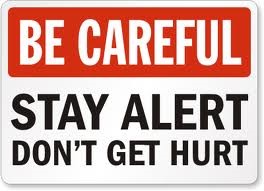A Self-Protection Guide
1) You can help protect yourself from violent crimes.
 Self-protection involves:Avoiding crime
Self-protection involves:Avoiding crime
* Without a doubt prevention is your best prevention against crime.
Knowing what to do in case of an attack
* An attack can happen despite your best efforts to prevent it. But you can start today to learn how to respond during and after any attack.
Violent crime can happen to anyone, anywhere, in any situation
* Victims and attackers come from all economic classes' and cultural background. Often, victims know their attackers.
* Violent crimes can happen anywhere day or night.
2)There's a lot you can do to reduce your risks.
Stay out of isolated areas.
* Avoid little-used stairwells, parking lots and roads.
* Don't get on an empty elevator with a stranger. 
Trust your instincts.
* If you sense trouble, get away as soon as possible.
Show confidence.
* Walk at a steady pace. Keep your head up.
* Avoid carrying lots of packages it c
an make you look defenseless. 
Practice Street Smart
* Plan the safest route before you leave.
* Dress comfortably, so you can move quickly if you have to.
* Don't wear headphones. It's important to stay alert!
* Vary your jogging or biking route, and bring a friend.
* If someone follows you, change course and head toward the other place.
* Stand back from the car when giving motorist directions.
Always pay attention to your surroundings and people in them!
3) Have a safe trip every time!
 To help protect yourself:
To help protect yourself:
In your car
* Park well-lit spot close to your destination.
* Never park next to a van. It's easy for attacker to hide inside.
* When returning to your vehicle, have your keys out. From a distance, check underneath your car. Check the back seat before getting in.
* Keep doors locked and windows up.
* Be sure you've got plenty of fuel.
* Keep your car in good repair so it's less likely to break down.
* Don't hitchhike or pick up hitchhikers.
When using public transportation
* Wait at busy, well-lit stops.
* Sit close to the driver or conductor.
* Speak loudly or yell if you feel threatened.
For extra security, consider carrying a mobile phone or taking a self-defense class.
4) Be safe at home
Taking these steps can help reduce your risks:
Secure your home
* Keep doors and windows locked.
* Use deadbolt locks on outside entrances.
* Never hide keys outside your home.
* Keep at least one inside light on when you're away.
* Keep outside entrances well lit.
* Get to know your neighbors.
Be wary of strangers
* Install a peephole in your front door and use it.
* Ask to see the ID of any repair or delivery person before opening your door. Call the company to verify, if you weren't expecting anyone.
* Never let a stranger into your home, and never let him or her know you're alone. If someone wants to use your phone, offer to make the call for him or her.

If you think someone is in your home, don't go in! Call the police or sheriff from nearby phone.
5) Use caution on dates and in relationships
Practice safe, smart dating.
* Beware of alcohol and other drugs. They affect judgment. Watch how much your date uses them too.
* Don't leave your drink alone. Don't drink anything you didn't get, open or pour yourself.
* (For women) "Date rape drugs" mixed in drinks can leave you at risk.
* Make your sexual limits firm and clear.
* Be independent. Don't let your date make all the decisions.
 * Provide your own transportation.
* Provide your own transportation.
* Avoid secluded transportation.
Know the warning signs of abuse.
Watch for behavior and attitudes in your date, partner or friend that signals trouble. For example, he or she may:
* Show a lack of respect for your feelings or ideas.
* Want to make all your decisions.
* Frequently display anger, mistrust or jealousy
* Misuse alcohol or use other drugs.
6) Responding to an attack
Only you can decide how to respond, and no one strategy will work every time. But in general:
 Size up the situation.
Size up the situation.
You have several options. Many women will:
* Scream for help or yell "Fire!"
* Run away
* Fight back.
* If you think resisting would put you in more danger, cooperate. Remember that your survival is most important do whatever you think is best.
Act quickly
* Whatever you choose to do, do it quickly. Never feel guilty about how you did or did not respond.
If you've been attacked or raped:
* Get to a safe place. Get in contact with a friend, relative or rape crisis center.
* Go to the hospital. Don't shower, brush your teeth, douche, and comb or clean any part of your body, or change your clothes. This might destroy medical evidence. Ask about treatment to help prevent pregnancy and STDs (Sexually transmitted diseases).
* Tell the police or sheriff. If you have concerns, get information and support first from a rape crisis center, for example, (Hospitals may be required to report some rape cases to authorities.)
* See a counselor or call a rape hotline.
* Remember an attack is never you fault. Don't blame yourself.
You can take charge of your personal safety!
Works Cited
Channing Bete Company Inc. Woman and Safety A Self-protection Guide South Deerfield: Channing Bete, 2003. Print.
Just updated your iPhone? You'll find new emoji, enhanced security, podcast transcripts, Apple Cash virtual numbers, and other useful features. There are even new additions hidden within Safari. Find out what's new and changed on your iPhone with the iOS 17.4 update.




Be the First to Comment
Share Your Thoughts